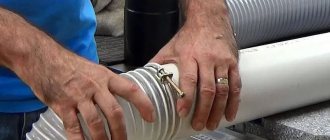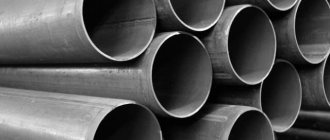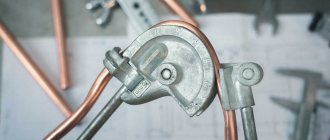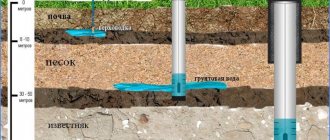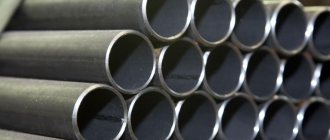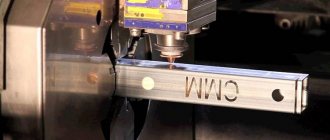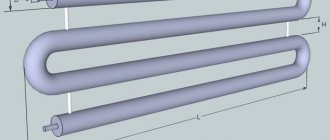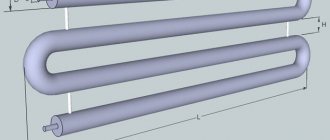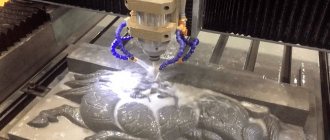Bending profile pipes is a fairly common procedure, for which a special device is used - a pipe bender. You can make a pipe bender for a profile pipe with your own hands, or you can purchase it at the construction market or in a store.
One of the simplest types of pipe bender for profiled pipes
Serial devices differ in their operating principles, they may have different types of drives, but operating any of these devices requires some experience. The use of devices manufactured in production conditions is limited by the fact that they are not cheap. A good solution in all such situations would be to independently manufacture a device designed for bending profile pipes, for which you can use improvised means.
What types of pipe benders are there?
Benders for profile and round pipes are usually divided into several types according to the principle of operation:
- Manual or mechanical. In such designs, the user himself sets the desired bending angle, and then rolls the pipe through rollers to give it shape. The advantages of pipe benders include low cost and compactness.
The disadvantage of manual profile pipe benders can be considered low accuracy - Hydraulic. A comparison of pipe benders shows that such models are more advanced because they work faster, are capable of bending steel workpieces with walls up to 4 mm, and at the same time they are quite easy to use. The operating principle of the hydraulic drive is the same as that of a car jack.
Hydraulic profile pipe benders are compact and large-sized for stationary use - Electrical. Models are equipped with a gearbox or hydraulics, but in any case they come into action when the electric drive is started. The user is not required to exert any effort to bend the profile pipe.
Electric pipe benders can handle workpieces of almost any diameter, but are expensive
For private needs, manual and hydraulic pipe benders are most often chosen. They have an optimal price-performance ratio.
Stationary pipe bender: step-by-step instructions
If you plan to make your own greenhouse from steel pipes, then you will need to acquire not just an ordinary pipe bender, but a reliable product.
After all, with this approach you will need to bend more than a dozen profile pipes. To make the greenhouse design neat and beautiful, you need to use a stationary pipe bender. Before you start making a greenhouse, you need to make sure that you have the appropriate tool for bending profile products. The following elements will be needed to construct a stationary pipe bender:
- rod at 25;
- 6 bearings;
- channel.
You will also need a welding machine, which will be used to connect all the components. Step-by-step instructions for making a stationary pipe bender are as follows:
- Bearings are welded to the base (channel), which are connected to each other by a shaft in the form of a steel pipe of the appropriate diameter.
- To prevent the shaft from being located too close to the base, the bearings should be welded onto 5 cm pieces of rectangular pipe.
- In order to deliberately produce a unit with which the bending radius could be adjusted, the base must be made of two channels connected to each other by curtains, as can be seen in the photo above.
- Two shafts with bearings are located at the same height, and the third (central) is welded using a rectangular tube 15-20 cm higher.
- An additional tube needs to be welded to the upper shaft, to which the handle will be attached. This shaft will be driven by muscular force.
- The handle is welded to the upper shaft, after which the resulting product can be checked for functionality.
When installing a profile tube of any size, you should adjust the radius of the final bend. This can be done using a jack located under the base on which one of the shafts is fixed. Having adjusted the required bending radius, the handle rotates. The result is high-quality curved tubes. The advantage of a pipe bender is the ability to bend materials of any size and diameter.
Among the disadvantages, we can only note the possibility of operation in one place
It is important to understand that such a device can be used for any need. To manufacture such a device, an investment of no more than 500 rubles will be required.
You only need to buy 6 bearings, and all the other elements can be found in every craftsman’s household.
How to choose a pipe bender for a profile pipe
When purchasing a pipe bender for your home or workshop, you need to pay attention to several parameters. Among them are the purpose of the tool and its functionality.
Operating principle
Profile pipe benders come in three-roller and angular types. The former are most often used in production; they allow you to bend the pipe evenly along its entire length with maximum precision and accuracy. Tools of the second type help to perform bending in a specific area; usually they are chosen for personal purposes.
Functionality
Some models of pipe benders work only with profile or round pipes, others are equipped with replaceable segments and are suitable for workpieces of all types. Universal bending machines are more convenient. With their help, you can give the desired shape to round and square pipes, as well as metal strips and reinforcement rods.
Tool dimensions
Manual pipe benders are usually compact; some hydraulically driven models can also be considered mobile. But electrical equipment requires installation in a specific location on a rigid base and is large in size and weight. When choosing a pipe bender for a profile pipe, you need to think in advance whether you will have to transport the tool from place to place, and how convenient it will be to do this.
Classification of pipe bending devices
Devices for bending steel pipes are classified:
- by degree of mobility (stationary and portable);
- by type of drive (manual, electric, hydraulic, electrohydraulic);
- according to the method of influence (running in (roller), winding, impact with a rod (crossbow), rolling).
The essence of how a pipe bender influences a pipe is as follows.
Run-in
With this method, one end of the pipe is clamped, and a stationary template is used to give it the required bend. Pressure rollers are used to roll the product around the template.
Drawings of a rolling pipe bender
Winding
In such a device, the pipe is pressed against a movable template (roller), on which it is wound, stretching between a rotating roller and a special stop installed at the beginning of the bending point.
Diagram of a pipe bender operating on the winding principle
Crossbow pipe benders
In such a pipe bender, the pipe rests on two stationary rollers, and bending is performed by a template, which is attached to a movable rod. The template presses on the middle of the fixed section of the pipe, thereby giving it the required bending angle.
Diagram of a crossbow pipe bender: 2 - jack, 3 - shoe (punch)
Rolling or rolling
The required bending radius is obtained using a three-roll device, the basis of which is two support rollers and one central roller. The central roller exerts pressure on the pipe, the position of which determines the radius of its bend. is more universal; in all other machines the bending radius depends on the template used.
Compact size manual rolling pipe bender
The manufacture of a pipe bender operating on the winding principle is not simple, so such a device is made mainly in an industrial way. The crossbow method has another significant drawback: the pressure from the rod with a template attached to it, called a shoe, is concentrated in its upper part. This method of acting on the pipe leads to its significant stretching along the outer radius of the bend, which may be accompanied by a decrease in wall thickness and even its rupture. It is especially not recommended to use the crossbow method for bending thin-walled products.
An example of a homemade rolling (rolling) type pipe bender
A machine operating on the principle of rolling (rolling) practically does not have all of the above-mentioned disadvantages; this technology is used in the production of bends in the factory.
A DIY pipe bending machine can have a different design. You should choose its type based on what radius you need. There is a list of recommendations, in accordance with which the choice of a specific model of device for bending steel pipes is made. Important parameters that need to be taken into account are the thickness of the pipe walls and its overall diameter. Before starting to work with a pipe bender, it would not hurt to familiarize yourself with the data in the table showing the maximum possible radii for bending steel pipes.
Dependence of the bending radius on the diameter and wall thickness of the pipe
To obtain a bend radius smaller than that specified in such recommendations, it is necessary to use hot rolling, which is used mainly in production conditions. A device with a mandrel is more difficult to create at home, so they are much less likely to be made independently, giving preference to rolling ones.
In order to independently hot-roll a pipe, you can resort to using a home-made pipe bender, but provided that it is made entirely of metal and its frame is highly reliable. To perform such a technological operation, you will additionally need a blowtorch or gas burner.
Rating of the best hydraulic pipe benders for profile pipes
Hydraulic manual benders for profile pipes are in particular demand. Their prices are usually reasonable, and such machines are easier to handle than mechanical equipment. It is necessary to apply less force to form a bend.
APV-9 Professional
The Russian pipe bender is suitable for performing work both in the home workshop and on the road. The universal model supports three types of bending and interacts with both round and profile pipes. The device is equipped with thermally hardened prefabricated rollers, which allow you to independently set the dimensions of the groove; the elements are made of high-strength steel.
The hydraulic jack of the pipe bender has a lifting capacity of 10 tons and copes with workpieces of increased hardness. Allows you to work with both large and small pipes.
The average cost of a profile pipe bender APV-9 is 30,000 rubles
Metal Master APV-200
The compact but powerful hydraulic machine is capable of bending profile pipes with a maximum diameter of 60/40/2. The tool rollers are thermally hardened and have a high safety margin. There are a total of two clamping elements and one leading upper element. Thanks to the bearings, the rollers rotate easily, the side rollers can move in a horizontal plane, which provides a wide bending radius.
Important! The machine for profile pipes can be installed in a workshop, or you can take it with you to sites. The equipment fits easily into the trunk.
The average cost of a hydraulic pipe bender APV-200 starts from 69,000 rubles
Metal Master TGA 40
The hydraulic profile pipe bender allows you to deform square and round pipes, as well as bend reinforcement and steel strips. Suitable also for the manufacture of railings, greenhouse elements and decorative parts. Suitable for both home and industrial use, the machine is used in construction, mechanical engineering and instrument making.
Demonstrates high resistance to operational loads. It is quite easy to operate, the workpiece is fed manually, and the hydraulic clamp ensures fast and accurate deformation. Suitable for processing profile pipes with a diameter of up to 40 mm.
You can buy a TGA 40 hydraulic machine from 20,000 rubles
Pipe benders - design and types
If to manufacture a structure it is necessary to bend a profile pipe along a radius, then a pipe bender can easily cope with this, with which you can make a bend up to an angle of 180 degrees. This device is capable of changing the configuration of pipes made of stainless steel, metal-plastic, and aluminum. In this case, the bending is carried out according to the required dimensions and shape.
Pipe bender design
The design of such a tool depends on its type. However, the required elements are:
- hydraulic cylinder - the main part of the machine that performs the power function;
- open or closed frame;
- two pipe stops;
- lower and upper bars;
- injection device, handle and bypass valve located on the rear of the structure body;
- retractable rod, which provides the bending force of the pipe bender;
- a spring with the help of which the retractable rod returns back;
- a trunnion or stop of a structure, the ends of which are inserted into holes in the slats.
On top of the main part of the machine there can be a level check and an oil fill plug. Installation strips, which are a welded structure, are screwed onto the threaded part of the tool. The bottom bar is secured with a locking nut, and the top bar is pressed with two screws and a lock.
To install supports, special holes are provided on the transverse plates of the device. The bottom of the pipe bender has threaded holes for mounting bolts that are height adjustable.
The bent pipe on such a structure is located on a stream, which is located in the middle of its stop. The bending segments must be made of precision cast steel.
Today, thin-walled profile pipes with thin walls are increasingly used for the manufacture of various structures. Therefore, the design drawing of a pipe bender for such workpieces is somewhat different. To prevent deformation of its cross-section when bending the pipe, profile rollers should be selected with the same cross-section as the product.
Types of pipe benders
Commercially available professional pipe benders can be manual, electric or hydraulic driven.
Electromechanical tools are considered the most convenient
The manual drive design is used for bending small diameter pipes.
Hydraulically driven pipe benders are capable of bending workpieces that can be up to three inches in diameter. Therefore, such a tool is designed to perform large-scale work.
In addition, pipe benders may differ in the way they influence the product, with the help of which it will be bent. These methods include:
- Crossbow method, in which the pipe rests on two stationary rollers and bends between stops under the influence of a template located on the rod.
- Winding - with this method of bending, the workpiece first attaches itself to the roller of the structure. Then a stop is placed at the bending point. The roller begins to rotate and wind the pipe between itself and the stop. In this case, the template and the product are movable.
- Rolling is the simplest way to bend a pipe. On such a device the template is motionless. The pipe is simply clamped and the pressure roller moves and bends the pipe around the template.
- The rolling or rolling method involves the use of three rotating rollers. One of them is central, and two are supporting. The central roller presses on the workpiece, so it must be installed relative to the supporting elements in accordance with the required radius of the product.
pressure from the rod is transferred to the workpiece at the top point of the template
The rolling method has virtually no disadvantages. It is by rolling that steel bends are manufactured in the factory. Using the same method, it is much easier and more efficient to bend profile pipes.
Top 5 best manual pipe benders for profile pipes
Hand tools for bending profiles can be either mechanical or hydraulic. But both types of models are easy to use, moderate in cost and reliable.
Stalex HTR-40
A universal pipe bender for steel profiles with adjustable rollers allows you to roll workpieces with a diameter of 15-40 mm and a wall thickness of 1.5 mm. The bending radius can be changed quickly and easily during the process. The manual machine is equipped with hydraulics with a lifting capacity of 2 tons, there are return springs that bring the pressure roller back to the upper position without effort on the part of the user.
A compact and powerful pipe bender is suitable for making railings, canopies, canopies and other structures that use profile pipes. Since the machine is operated manually, it can be used anywhere, regardless of the availability of electricity.
You can buy a pipe bender HTR-40 from 16,000 rubles
Proma KO-200
The machine is designed for cold bending of steel rods, profile pipes and metal strips; it works with medium-hard materials. Equipped with a wide base for greater stability, it can also be mounted on a workbench using four holes. It is lightweight and small in size, making it easy to transport. Suitable for processing square and round pipes, the maximum bending angle is 200°.
You can buy a Proma profile pipe bender from 13,000 rubles
Stalex TR-60
A manual pipe bender with an extended working lever allows you to easily give the desired bend to metal workpieces with minimal force. The body is equipped with a ruler to control the deformation radius; the machine works with square and round pipes of 15-38 mm. Made of powder coated steel, suitable for stationary and tabletop installation.
Important! The disadvantage of the model can be considered the lack of rollers for working with profile pipes in the kit. However, they can be purchased separately.
The average price of Stalex TR-60 starts from 16,000 rubles
Blacksmith MTB10-40
A manual pipe bender without an electric drive or hydraulics, however, is simple and reliable. The machine is equipped with three rollers - between them you need to clamp the workpiece and turn the handle to accurately bend the pipe. The angle is adjusted using the upper roller; it is pressed harder or weaker.
The effort required from the user is minimal; the budget machine is very functional and easy to use. The only negative is that in the absence of experience, controlling the flexion angle may cause difficulties.
The average cost of MTB10-40 starts from 14,000 rubles
Smart & Solid BendMax-300
The manual profile bender is designed to work with 50/30/2 mm pipes. The machine is made of durable steel with a two-layer zinc coating and is reliably protected from corrosion. Among the advantages are reliability, high-quality assembly and ease of operation. The tool can be used both at home and in small workshops.
You can purchase a bender for profile pipes BendMax-300 from 18,000 rubles
How to make a profile bending machine with your own hands?
Not every novice craftsman is able to purchase a ready-made factory-type machine for bending metal pipes, since this is quite expensive equipment.
Drawing of a bending machine.
As an alternative, you can try to make a manual machine yourself, following the following instructions:
- Place gears, bearings, rings connected with a key on the pressure shaft. Turn out the cages for bearings and rollers according to a previously prepared drawing of such a shaft. Also for the unit it is necessary to make three shafts, one of which is suspended on springs, and the other two are installed on the sides.
- Drill holes in the rings to create grooves and threads, and then make a shelf using a channel with pre-arranged holes and threads required when installing the pressure shaft.
- After preparation has been completed, the machine structure is assembled using a welding machine and bolted connections. First, install the frame, which simultaneously serves as the legs of the pipe bender.
- Next, hang the shelf on springs with a pressure shaft fixed on it, after which you should install the side support shafts on a homemade pipe bender. Don't forget to attach a handle to one shaft.
- Finally, you need to install a jack on the machine and it is ready to go.
Rating of pipe benders for round pipes
In production, repairs and decorative work, it is necessary to bend not only profiles, but also round blanks. Several models of manual pipe benders are in demand.
Rothenberger Minibend
The mobile hand-held pipe bender weighs only 420 g and is suitable for bending round pipes at an angle of up to 180°. Works with copper, aluminum and brass workpieces, and copes with thin-walled steel. Supports pipe diameters of 6-10 mm. Among the disadvantages, users note only a small range of applications.
Advice! The pipe bender is best suited for repairing refrigeration units and for plumbing work.
The average cost of a Rothenberger pipe bender starts from 2,700 rubles
YATO
A very budget-friendly Chinese manual pipe bender is designed to work with workpieces with a diameter of up to 20 mm. Equipped with a measuring scale for setting the bend angle and a lock for stopping the tool at the right time. It is not suitable for deforming large and high-strength pipes, but it copes well with basic household tasks.
You can buy a YATO pipe bender for only 700 rubles
Force 653180
A manual pipe bender with a long handle is designed to change the geometry of pipes with a thickness of 6-20 mm. Made from a metal alloy, it is highly durable and interacts even with steel. Performs bending up to 180°. The design of the equipment is simple, the instrument can be easily transported.
The price of the Force pipe bender starts from 1200 rubles
How to mechanize the process
Since the hydraulic drive has the greatest autonomy, in most cases it is used. As a source of generated pressure at home, you can use a conventional hydraulic jack. It is installed on top of the movable roller of the pipe bender and under the mandrel. By moving the jack handle, the necessary bending pressure is created.
The choice of standard size of a jack for a pipe bender depends on the plasticity limit of the workpiece material:
- For steels of type St3, steel 10 – 120...130 MPa;
- For steels of type St.5, steel 20 – 130...150 MPa;
- For brass – 80…100 MPa;
- For aluminum - 60...80 MPa.
When choosing a standard size, the stroke of the rod is also taken into account, which cannot be less than 115....120% of the final height of the curved pipe (inevitable springing is taken into account)
Rating of the best electric pipe benders
Electrically driven pipe benders for regular and profile pipes are of particular interest. To work with them, you do not need to put in any effort; automation is responsible for the entire process of deforming the workpieces. But the cost of such machines is very high; they are usually purchased for production purposes.
3RE-30 Junior
An electromechanical machine with two drive rollers guarantees high bending accuracy for 30 mm round pipes and profile workpieces. Equipped with a remote hand-held control panel, it operates in horizontal and vertical positions. Does not require specialized commissioning before use.
You can purchase an electric pipe bender 3RE-30 Junior from 160,000 rubles
Tor HHW-G76
The Russian machine for round and profile pipes with a maximum diameter of 80 mm is equipped with a 2 kW motor. Control is carried out through a manual or foot drive; the pressure roller is adjusted manually. After setting the desired angle and placing the workpiece, all that remains is to put the device into operation. To increase the bending angle, reverse rolling is provided. The machine carefully deforms profile pipes without flattening or breaking them.
You can buy a pipe bending machine HHW-G76 from 79,000 rubles
BMK-55U
The three-roll production pipe bender handles workpieces up to 80 mm in one pass. Works with steel, chrome-plated, nickel-plated pipes and does not even damage the polymer or paint coating. Due to two screw clamping systems, it ensures high bending accuracy, and control is carried out through a remote control panel.
The cost of the BMK-55U machine starts from 515,000 rubles
